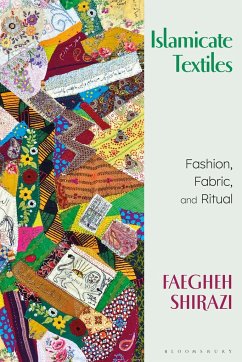- Broschiertes Buch
- Merkliste
- Auf die Merkliste
- Bewerten Bewerten
- Teilen
- Produkt teilen
- Produkterinnerung
- Produkterinnerung
An insider's perspective on the diversity of textile traditions, culture and religious practices across Muslim cultures.
Andere Kunden interessierten sich auch für
![Crafting Textiles in the Digital Age Crafting Textiles in the Digital Age]() Crafting Textiles in the Digital Age34,99 €
Crafting Textiles in the Digital Age34,99 €![The Story of Colour in Textiles The Story of Colour in Textiles]() Susan Kay-WilliamsThe Story of Colour in Textiles35,99 €
Susan Kay-WilliamsThe Story of Colour in Textiles35,99 €![Sewing Techniques Sewing Techniques]() Jennifer PrendergastSewing Techniques26,99 €
Jennifer PrendergastSewing Techniques26,99 €![Cultural Threads Cultural Threads]() Jessica HemmingsCultural Threads49,99 €
Jessica HemmingsCultural Threads49,99 €![Catalogue of Textiles From Burying-grounds in Egypt; 1 Catalogue of Textiles From Burying-grounds in Egypt; 1]() Catalogue of Textiles From Burying-grounds in Egypt; 118,99 €
Catalogue of Textiles From Burying-grounds in Egypt; 118,99 €![English, French & American Furniture, Porcelains, Bronzes, Silver, Textiles and Tapestries, Eastern Rugs and Carpets English, French & American Furniture, Porcelains, Bronzes, Silver, Textiles and Tapestries, Eastern Rugs and Carpets]() English, French & American Furniture, Porcelains, Bronzes, Silver, Textiles and Tapestries, Eastern Rugs and Carpets20,99 €
English, French & American Furniture, Porcelains, Bronzes, Silver, Textiles and Tapestries, Eastern Rugs and Carpets20,99 €![Block Printing on Textiles Block Printing on Textiles]() Janet Doub EricksonBlock Printing on Textiles18,99 €
Janet Doub EricksonBlock Printing on Textiles18,99 €-
-
-
An insider's perspective on the diversity of textile traditions, culture and religious practices across Muslim cultures.
Produktdetails
- Produktdetails
- Verlag: Bloomsbury Academic
- Seitenzahl: 208
- Erscheinungstermin: 3. April 2025
- Englisch
- Abmessung: 229mm x 152mm x 15mm
- Gewicht: 454g
- ISBN-13: 9781350291263
- ISBN-10: 1350291269
- Artikelnr.: 70011749
- Herstellerkennzeichnung
- Libri GmbH
- Europaallee 1
- 36244 Bad Hersfeld
- gpsr@libri.de
- Verlag: Bloomsbury Academic
- Seitenzahl: 208
- Erscheinungstermin: 3. April 2025
- Englisch
- Abmessung: 229mm x 152mm x 15mm
- Gewicht: 454g
- ISBN-13: 9781350291263
- ISBN-10: 1350291269
- Artikelnr.: 70011749
- Herstellerkennzeichnung
- Libri GmbH
- Europaallee 1
- 36244 Bad Hersfeld
- gpsr@libri.de
Faegheh Shirazi is a Professor in the Department of Middle Eastern Studies at the The University of Texas at Austin, USA. Her research interests include textiles, dress, gender identity discourse, and material culture in the Middle East; the meanings of veiling; rituals and rites of passage as they relate to material culture.
Introduction
1. Textiles and Symbols: A Mélange of Cultural Signifiers
Kanga: Cloth with a message
Lion of Persia: From pre-Islamic to contemporary Iran
Felt and fabrics under domination: Central Asia
Ram's horn: Central Asia and Iran
2. Talismanic Textiles: Gender, Status, and the Supernatural
Protecting fiber and livelihood: The Ladakh
Blessed looms, blessed fibers
Sacred colors: Red, white, and light blue
Beyond the loom
Amulets: Protection against the unseen
Inscribed talismanic shirts
Gendered looms
3. The Politicization of Textiles: Colonialism to the Present
India and cotton: rejecting colonial rule
United we stand: India's Muslim weavers
West African wax cloth
Calico: The forbidden African cotton
Indian cloth in Southeast Asia
Keffiyeh: From functional to symbolic
The effect of Russian colonization on Central Asian politics
Tajikistan: Textiles and national branding
Soviet symbols on woven carpets
4. Refugees and Displaced Persons: Textile Signatures
The Siddis of India
Afghan refugee women: Embroidered lives
Weaving and war: Carpets depicting a nation under siege
Iraqi refugees: Textile arts of the past
Syrian and Iraqi refugees: Embroidered quilts and the charuga
Syrian refugees: The Ana collection
Weaving timeless symbols: War's impact on non-Muslim communities
5. Textiles and Death Rituals in Islamicate Societies
The burial garment for Muslims: The kafan
Piecing together the past
Tomb covers for the Prophet Muhammed: Kiswah
Tomb covers: Signifiers or status
Indian and South Asian tomb covers
Egyptian funeral tents: The art of Khayamiya
Conclusion
Glossary
Bibliography
Index
1. Textiles and Symbols: A Mélange of Cultural Signifiers
Kanga: Cloth with a message
Lion of Persia: From pre-Islamic to contemporary Iran
Felt and fabrics under domination: Central Asia
Ram's horn: Central Asia and Iran
2. Talismanic Textiles: Gender, Status, and the Supernatural
Protecting fiber and livelihood: The Ladakh
Blessed looms, blessed fibers
Sacred colors: Red, white, and light blue
Beyond the loom
Amulets: Protection against the unseen
Inscribed talismanic shirts
Gendered looms
3. The Politicization of Textiles: Colonialism to the Present
India and cotton: rejecting colonial rule
United we stand: India's Muslim weavers
West African wax cloth
Calico: The forbidden African cotton
Indian cloth in Southeast Asia
Keffiyeh: From functional to symbolic
The effect of Russian colonization on Central Asian politics
Tajikistan: Textiles and national branding
Soviet symbols on woven carpets
4. Refugees and Displaced Persons: Textile Signatures
The Siddis of India
Afghan refugee women: Embroidered lives
Weaving and war: Carpets depicting a nation under siege
Iraqi refugees: Textile arts of the past
Syrian and Iraqi refugees: Embroidered quilts and the charuga
Syrian refugees: The Ana collection
Weaving timeless symbols: War's impact on non-Muslim communities
5. Textiles and Death Rituals in Islamicate Societies
The burial garment for Muslims: The kafan
Piecing together the past
Tomb covers for the Prophet Muhammed: Kiswah
Tomb covers: Signifiers or status
Indian and South Asian tomb covers
Egyptian funeral tents: The art of Khayamiya
Conclusion
Glossary
Bibliography
Index
Introduction
1. Textiles and Symbols: A Mélange of Cultural Signifiers
Kanga: Cloth with a message
Lion of Persia: From pre-Islamic to contemporary Iran
Felt and fabrics under domination: Central Asia
Ram's horn: Central Asia and Iran
2. Talismanic Textiles: Gender, Status, and the Supernatural
Protecting fiber and livelihood: The Ladakh
Blessed looms, blessed fibers
Sacred colors: Red, white, and light blue
Beyond the loom
Amulets: Protection against the unseen
Inscribed talismanic shirts
Gendered looms
3. The Politicization of Textiles: Colonialism to the Present
India and cotton: rejecting colonial rule
United we stand: India's Muslim weavers
West African wax cloth
Calico: The forbidden African cotton
Indian cloth in Southeast Asia
Keffiyeh: From functional to symbolic
The effect of Russian colonization on Central Asian politics
Tajikistan: Textiles and national branding
Soviet symbols on woven carpets
4. Refugees and Displaced Persons: Textile Signatures
The Siddis of India
Afghan refugee women: Embroidered lives
Weaving and war: Carpets depicting a nation under siege
Iraqi refugees: Textile arts of the past
Syrian and Iraqi refugees: Embroidered quilts and the charuga
Syrian refugees: The Ana collection
Weaving timeless symbols: War's impact on non-Muslim communities
5. Textiles and Death Rituals in Islamicate Societies
The burial garment for Muslims: The kafan
Piecing together the past
Tomb covers for the Prophet Muhammed: Kiswah
Tomb covers: Signifiers or status
Indian and South Asian tomb covers
Egyptian funeral tents: The art of Khayamiya
Conclusion
Glossary
Bibliography
Index
1. Textiles and Symbols: A Mélange of Cultural Signifiers
Kanga: Cloth with a message
Lion of Persia: From pre-Islamic to contemporary Iran
Felt and fabrics under domination: Central Asia
Ram's horn: Central Asia and Iran
2. Talismanic Textiles: Gender, Status, and the Supernatural
Protecting fiber and livelihood: The Ladakh
Blessed looms, blessed fibers
Sacred colors: Red, white, and light blue
Beyond the loom
Amulets: Protection against the unseen
Inscribed talismanic shirts
Gendered looms
3. The Politicization of Textiles: Colonialism to the Present
India and cotton: rejecting colonial rule
United we stand: India's Muslim weavers
West African wax cloth
Calico: The forbidden African cotton
Indian cloth in Southeast Asia
Keffiyeh: From functional to symbolic
The effect of Russian colonization on Central Asian politics
Tajikistan: Textiles and national branding
Soviet symbols on woven carpets
4. Refugees and Displaced Persons: Textile Signatures
The Siddis of India
Afghan refugee women: Embroidered lives
Weaving and war: Carpets depicting a nation under siege
Iraqi refugees: Textile arts of the past
Syrian and Iraqi refugees: Embroidered quilts and the charuga
Syrian refugees: The Ana collection
Weaving timeless symbols: War's impact on non-Muslim communities
5. Textiles and Death Rituals in Islamicate Societies
The burial garment for Muslims: The kafan
Piecing together the past
Tomb covers for the Prophet Muhammed: Kiswah
Tomb covers: Signifiers or status
Indian and South Asian tomb covers
Egyptian funeral tents: The art of Khayamiya
Conclusion
Glossary
Bibliography
Index








